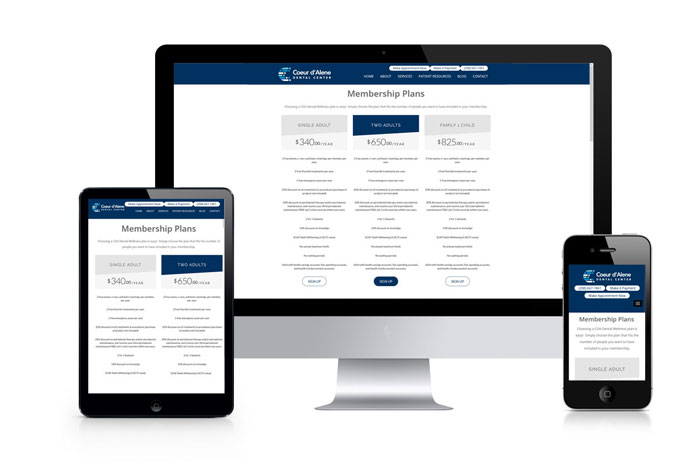10 Creative Ideas to Promote Dental Memberships in the Dental Office

A dental membership plan can play a big part in developing patient loyalty and increasing your practice’s revenue.
Offering annual in-office dental care plans directly to your patients also avoids the hassle of dealing with insurance companies and will appeal to those who may find it difficult to get insurance coverage – such as retirees and small-business owners.
Research indicates that dental membership program patients opt for up to twice as many treatments as uninsured patients and visit their dentist up to three times as often.
First, though, you need to get these types of patients to sign up for your dental membership plans. Here are 10 different ways to promote a dental membership plan within a dental office – and they’ve all been put to good use by DentalROI clients.
1. In-Office Counter Displays
In-house counter displays to promote your dental membership initiative provide an effective way to target existing patients, especially those without dental insurance who’s fretting over the difficulties of paying their next dental bill as they wait in your reception area.
Quality, easy-maintenance, customized counter top display signs are available in a range of styles and sizes, including compact digital options, and they allow you to market your dental membership program cost-effectively compared with other types of advertising.
2. Handout Cards
In the digital age, it can be easy to overlook the importance of traditional bespoke handout cards, which still have a valid marketing role and can help to increase your dental membership plan base.
Handout cards can be particularly helpful to reach out to people, not in the social media loop, and who still prefer things old-school – including those who find themselves without dental insurance on retirement.
3. Texting Patients
You’re probably already sending texts to your patients to remind them of appointments. As well as staying engaged with your patients and helping them get the dental care they need, these texts could also contain a message about the benefits of joining your dental membership plan.
Research has shown that text messaging is the preferred form of communication for many dental patients, especially older people, who may also be more likely to be thinking about dental membership plans.
4. Email Campaigns
Sending a single message to a large number of subscribers on your emailing list is a fast way to spread the word about your dental membership plan. If you can refine this email campaign to target those most likely to benefit from it, that’s even better and will avoid irritating other patients.
Tip: If you’re sending out emails like this, make sure you comply with the CAN-SPAM Act.
5. Facebook Posts
By 2023, the number of Facebook users in the States is expected to have risen to more than 223 million, and you can bet that your practice catchment area will contain a good number of Facebook fans.
Besides posting general dental topics on the largest social media platform in the world, you could include informative content to help people in your local community interested in dental membership programs – both existing and potential patients.
6. Twitter Posts
When not logging onto Facebook, millennials are likely to be busy tweeting – 80 percent of active users on Twitter are in the Gen Y demographic. They provide another key target market for your dental membership initiative – many millennials don’t have dental insurance, which means that routine dental care may well be costing them a significant amount of their income.
One advantage of Twitter is that it’s designed for bite-sized posts, so tweeting about your dental membership program is easier than putting together content for Facebook.
7. Instagram Posts
Instagram allows you to share smartphone pictures and short videos showcasing your dental membership plan – on the platform itself and across other social media, including Facebook and Twitter.
Instagram posts – highly effective in engaging with people on a positive emotional level – give you another resource to connect with millennials, and you can link your images to your location, targeting those likely to be looking for dental membership plans in your area.
8. Website Pop-Ups
Whatever your personal take on website pop-ups, they remain one of the best methods of generating leads – and they can do the same for your dental membership plans. Pop-ups give you the opportunity to focus on a specific call to action regarding the benefits of dental membership plans – standing out from all the other messages your website is trying to get across.
Pop-ups can also be less intrusive now, with several types designed for a better user experience.
9. Paid Ads
Paid online ads – like pay-per-click (PPC) marketing as opposed to free, organic search engine optimization (SEO) – typically provide a sound return on investment for dental offices, so why not use them as part of the marketing strategy for your dental membership plans? Google Ads is a major platform for paid ads, placing your ads in front of patients right when they are looking to make a decision.
10. Word-of-Mouth
Word-of-mouth is still a powerful aid in dental marketing and can lead to increased interest in your dental membership plan without costing you a cent. More than 90 percent of consumers say word-of-mouth recommendations are the main reason they acquire a service or product.
You can offer rewards through a loyalty program to your current dental membership plan patients to encourage them to recommend your membership plans. Benefits of a Streamlined Dental Membership Plan Properly thought through and implemented, these 10 different ways to promote your dental membership plan can help your practice to:
- Attract new patients.
- Keep existing patients.
- Cut out insurance company middlemen.
- Create a strong recurring revenue stream.
- Provide quality dental care to patients without dental insurance.
- Maximize value if you sell your practice.
If you want to streamline your dental membership plan, special software is available to automate the process.



Please login to publish a comment.
Comments (0)